In this post I will move forward on the analysis of Twitter datasets, that I have started in December. You can read the previous post, “About Iran and IRA Twitter datasets (for fun) – Part I”. This time I have focused on the potential Russian propaganda in Europe, so I have decided to analyse the tweets written in German, Italian, Spanish, French, Dutch and Danish. I have left out English tweets because it would have been difficult to separate the propaganda in the United Kingdom from the propaganda in the United States. In my own Python code, in order to read data I have mainly used these packages: pandas, langid, emoji, matplotlib and wordcloud. The module langid has been useful to classify the languages used in the users’ descriptions, it is not always correct, but it allowed me to make a comparison between the descriptions’ languages and the tweets’ languages. You can find a list of Python module to recognize the language of a text in this topic on StackOverflow. The module wordcloud allows to do awesome plots with words (thanks to Python-Graph-Gallery for the shared code).
Data About Accounts
I have focused on the users’ descriptions because they can give some interesting information, so I have tried to answer to some questions:
- In which languages are the descriptions written?
- What are the most common words¹ and the most common emoji?
- Is there a correlation between the languages of descriptions and the languages of tweets?
Iran Accounts
The dataset of Iranian users contains 770 accounts. Most users (83,9%) have ‘en’ (English) as account’s language, but the most used language in the tweets is French (35,9%), followed by English (20,1%) and Arabic (12,8%).
Important: I have not count the retweets, and I have excluded 31.594 tweets, classified by Twitter as ‘nan’ or ‘und’.

On the left, the most used languages in the descriptions, analysed with langid.py. On the right, the most used languages in the tweets.
By comparing the languages of the tweets and the languages of the descriptions, obtained with langid, I have found results more congruent among them. The set of the five most used languages in the tweets and the set of the most used languages in the descriptions had four elements in common: French (fr), English (en), Arabic (ar) and Persian (fa). The results obtained with langid could be inaccurate, but they are consistent with the data about the tweets’ languages. It is also interesting to see the most frequent words in the descriptions.

Words¹ with at least four characters and used at least by ten different users.
I have chosen to consider only the words with at least four characters (so as to exclude pronouns, articles and conjunctions) and used at least by ten different users (this is a subjective parameter to define a word “common”¹). I have found only ten words under these conditions and eight of them are in English (I have excluded the word ‘https’). The most frequent word is ‘journalist’, found in 18 descriptions, followed by ‘news’, used in 16 descriptions. In my own opinion it is an important fact about the Iranian propaganda: the users tried to seem credible to spread news. In addition to the words’ analysis, I have also analysed the emojis by using the python module emoji. In the descriptions of the Iranian accounts there are not many emojis, only 30 different ones, and the most used are 😜 and 🇯🇴, each of which appears in four descriptions.
Internet Research Agency Accounts
In the dataset of Internet Research Agency (Russian) users there are 3.836 accounts, almost five times the number of Iranian accounts (well, more fun!). The main accounts’ languages are ‘en’ (English, 62,1%) and ‘ru’ (Russian, 27,1%), following by ‘es’ (Spanish, 6,1%) and ‘de’ (German, 2,9%). It is interesting to compare these data with the ones of the tweets’ languages and the descriptions’ languages.

To analyse these data I have used the same rules as before. The percentages are more homogeneous for IRA users than for Iranian users: the two most frequent languages (used in the account’s settings, in the description and in the tweets) are English and Russian. There are 2.384 accounts (62,1%) with English language and 1.039 (27,1%) with Russian language, the descriptions written in English are 1.444 (51,3%) and ones written in Russian are 854 (30,3%), plus there are 2.178.513 English tweets (41,1%) and 2.839.839 Russian tweets (53,5%). There is only another language present in the five most used of every list, which is German. There are 111 accounts (2,9%) with German language and there are 86.259 tweets written in German (1,6%), after English and Russian tweets they are the larger group. In a set of 3.836 users, where 73% have a description, it is interesting to watch the most frequent words in their descriptions.

This cloud of words is more dense than Iranian one. The most common word is ‘follow’, it is in 203 descriptions, and circa 180 times it is followed by the pronoun ‘me’. If I exclude the words ‘that’ and ‘your’, the next most common words are: ‘love’ (128), ‘conservative’ (121), ‘life’ (119), ‘trump’ (103), ‘maga’ (96) and ‘news’ (78). The first not-English word is ‘люблю’ (64), that means ‘love’ in Russian. The most frequent words are in English and describe users with right-wing ideas who support Trump, but not all users are pro-Trump (e.g. the word ‘blacklivesmatter’ is in 27 descriptions). These results are consistent with the emoji in the descriptions: the two most frequent ones are ❤, present in 23 descriptions, and 🇺🇸, present in 16 descriptions. By remembering the FiveThirtyEight’s analysis about another dataset of (potential) IRA tweets, my own opinion is that the goal of IRA users was to polarize the readers.
Russian Propaganda in Europe
My own question is: has there been Russian propaganda in Italy and in Europe?
In Italy some journalists wrote about Russian influences in Italian politics via Twitter (Corriere della Sera [it] and Repubblica [it]), mainly by favoring the right, but with little evidence in the data. In the Twitter dataset of IRA tweets, there is the column tweet_language that identifies the language of each tweet, so I have compared the tweets written in six languages: German, Italian, Spanish, French, Dutch and Danish. My expectation was to find a common pattern, if there has been propaganda by using these languages.

On the left, the volume of the tweets and retweets for each language. On the right, the volume of the interactions (favorites + retweets + replies) for each language.
The first step is to compare the volume of tweets written in these six languages and the interactions generated by these tweets. On the left the amount of tweets and retweets written in German, Italian, Spanish, French, Dutch and Danish. There are many tweets and retweets in German and Italian, few in Spanish and French. This information is interesting because Spanish is the second most spoken language in the United States, spoken by fourty million people, and the second in the world as well, so I expected many tweets written in Spanish - I was wrong. Another interesting number is the ratio between tweets and retweets (#tweets / #retweets), for all these languages the ratio is greater than 1 except for Italian. On the right there are the volumes of the interactions (favorites, retweets and replies), divided by language. The volume of the interactions to the propaganda tweets written in German is much larger than the others: to make a comparison, the second largest volume (interactions with French tweets) is almost 13 times smaller. The Italian case is interesting again, there are 20.376 tweets (tweets + retweets) in Italian, +61% than French tweets, but the total interactions with the propaganda tweets in Italian are only 6.197, less than half of the total interactions to the tweets written in French. Looking at these two plots, my own conclusion is that in Germany there could have been Internet Research Agency propaganda and that Italy seems to be a “special”² case.
German
There are 99.332 tweets, of which 13.073 are retweets, in German. These tweets have generated 121.493 hearts, 74.693 retweets and 15.460 replies.

On the left, the pie plot of tweets and retweets in German. On the right, the pie plot of the interactions with these tweets.
The tweets (not including the retweets) in German are 86.259, they are the most frequent after the tweets in English and Russian. Among the six languages, it is the one with the highest ratio between tweets and retweets (6,6). Another interesting number is the percentage of replies: 7,3% (15.460 replies), it is the highest percentage among the six languages.
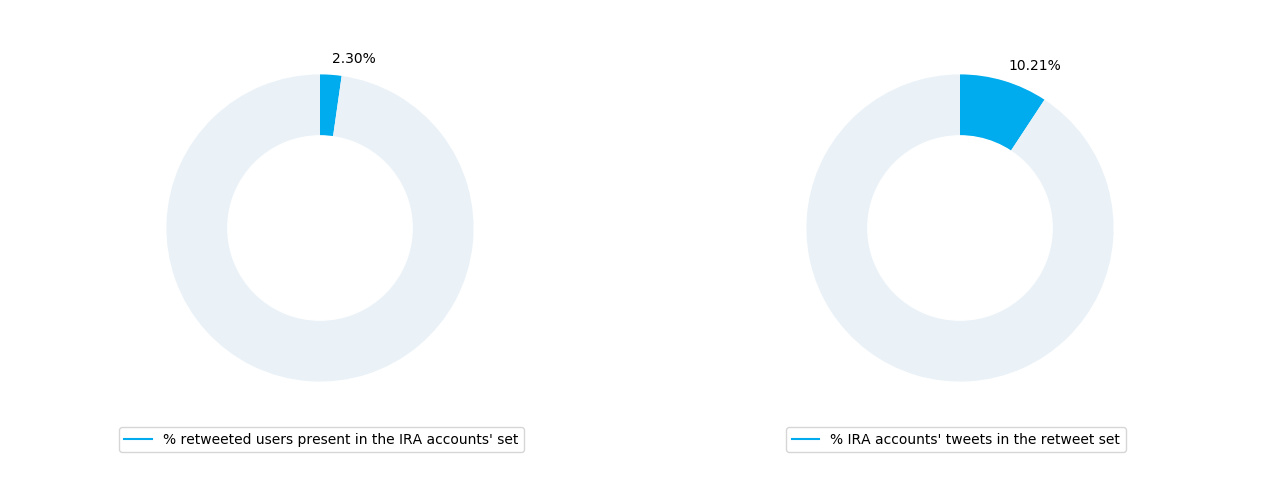
On the left, the percentage of IRA accounts that are the authors of the tweets retweeted by other IRA accounts. On the right, the percentage of tweets written by IRA accounts among the retweeted tweets.
I was surprised to see that Russian users have retweeted a small group of Russian users (only 70 propaganda accounts out of 3.036 retweeted users), but the tweets written by this small group are 10% of all retweets in German. I have created a word cloud with the most retweeted users (retweeted at least five times) to get a better view. For convenience I have replaced the Russian hashed users with the value “hashed_user_n”, where n is an index to count these users.

The word cloud of the most retweeted users (retweeted at least five times).
The twenty-one (21) most retweeted accounts are the authors of 25% of all retweeted tweets and they are 0,7% of all retweeted accounts. Among these there are many mainstream media and journalists (e.g. @welf, verified account of the newspaper “Die Welt”, @SPIEGELONLINE, verified account of the newspaper “Der Spiegel”, and @tagesschau, verified account of the television news provider “Tagesschau”), and three propaganda accounts (@erdollum and others two which are hashed because they have less than 5.000 followers). The user @erdollum was created in 2016 and had 7.691 followers, the others two were created in 2016 and 2015 and they had 4.654 and 938 followers each. If I increase the previous percentage up to 50%, I find that 135 users (4,4%) are the source of half of all retweeted tweets, of which 18 ones are IRA accounts. To get a full picture of the topics, I have also create a word cloud with the most common hashtags (by “common” I mean “used in at least ten tweets or retweets”).
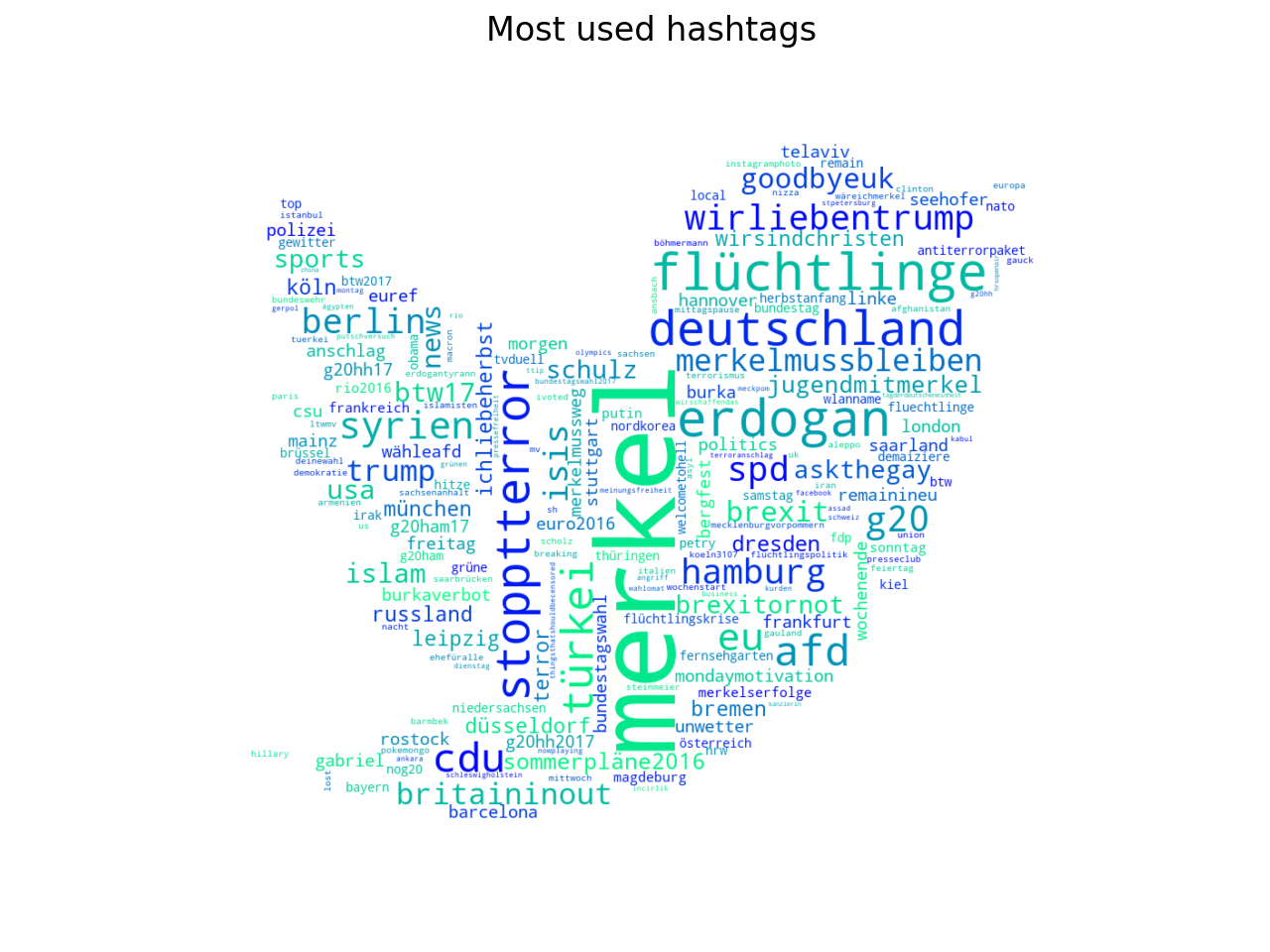
Word cloud of the hashtags used in at least ten tweets or retweets.
Reading the hashtags can be useful to understand what kind of news has been spread by the propaganda accounts. The word cloud confirms that Germany is one of the targets of Russian propaganda. There are 8.619 different hashtags used 61.795 times by the IRA users and the seventeen most frequent hashtags are 25% (15.516) of all used ones. The main hashtags are about few topics: internal politics, foreign politics, refugees, terrorism, Trump and Brexit. So #Merkel is the most used hashtag, 2.455 times, but Merkel also appears in the hashtags #MerkelMussBleiben (508), which means “Merkel has to stay”, #JugendMitMerkel (265), which means “Youth with Merkel”, and #MerkelMussWeg (144), which means “Merkel has to go”. It seems that it is not important to support an idea or not, the goal of Russian users is to polarize other users on the topic, but this is my own opinion by reading these numbers (you might like this report by Von Karolin Schwarz and Patrick Gensing). Some other hashtags about the internal politics are #AfD (876 times), acronym for the far-right party Alternative für Deutschland, #CDU (793), acronym for the liberal-conservative party Christlich Demokratische Union Deutschlands, and #SPD (559), acronym for the social-democratic party Sozialdemokratische Partei Deutschlands. The hashtag #Flüchtlinge (refugees) is repeated 1.308 times and the hashtag #Syrien 666 times. About foreign politics the hashtags #Erdogan and #Türkei are used 1.281 and 959 times each. The hashtag #Trump was written 472 times and there is an hashtag written in German to support Trump, #WirLiebenTrump ("We love Trump"), used 560 times. The hashtags about Brexit are interesting: #BritainInOut (459), #Brexit (444), #GoodbyeUK (415) and #BrexitOrNot (315). These hashtags are not for or against Brexit, but they are useful to create polarization. Anyway, the researchers Johan Farkas and Marco Bastos, in their paper “IRA Propaganda on Twitter: Stoking Antagonism and Tweeting Local News”, classify the German tweets about Brexit in two sets: Anti-EU Pro-Brexit and Pro-Eu Pro-Brexit.
To conclude this statistic I have extracted the emoji from 86.259 tweets. Russian users have used 313 different emoji, the most five frequent are 😂 (in 702 tweets), 😊 (in 472 tweets), 😘 (in 230 tweets), 🔴 (in 215 tweets) and 😉 (in 159 tweets). It is interesting to notice the little number of occurences of 🇺🇸, compared to the volume of tweets (e.g. in Italian and Spanish tweets there are more United States flag emoji, despite the lower volume of tweets, but there is a easy reason: the Twitter dataset isn’t always correct).
Important
The graphs for the next five languages are based on the same rules and conditions as the graphs built for the German language.
Italian
Earlier I have written the Italian case is special, because the number of retweets are much more than the one of tweets. It is the only one with this feature among the six languages, and it is also unique* among all other languages. There are 53 different languages across the set of all retweets, and only nine of them have more retweets than tweets, but among these the only language* with over 10.000 retweets is Italian (except Japanese (jp) with 1.543 retweets, the other seven languages have very small numbers).

There are 2.494 tweets and 17.882 retweets in Italian, but they have generated few interactions, only 2.889 hearts, 3.152 retweets and 156 replies. It is useful to compare these numbers with others, to better understand: there are 20.376 tweets (tweets + retweets) written in Italian and they have generated a smaller volume of interactions (hearts + retweets + replies) compared to French tweets (12.636) and interactions (16.351). The situation is similar if the comparison is made with Spanish numbers. The high number of retweets doesn’t seem to have influenced the number of generated interactions, by observing these six languages the number of interactions seems proportional only to the number of tweets (this is an unconfirmed hypothesis). It is interesting to know how many propaganda accounts have been retweeted.

2.113 different users have been retweeted and only 41 (1,9%) are Russian accounts. Only 156 tweets out of 17.882 were created by these propaganda accounts and then retweeted by other propaganda users. These tweets are 0,9% of all retweets, this percentage is very far from the German (10,2%) or Spanish (11,6%) ones and it is the lowest among the six languages. The Russian trolls prefered to retweet italian tweets by mainstream media and “trusted” sources.
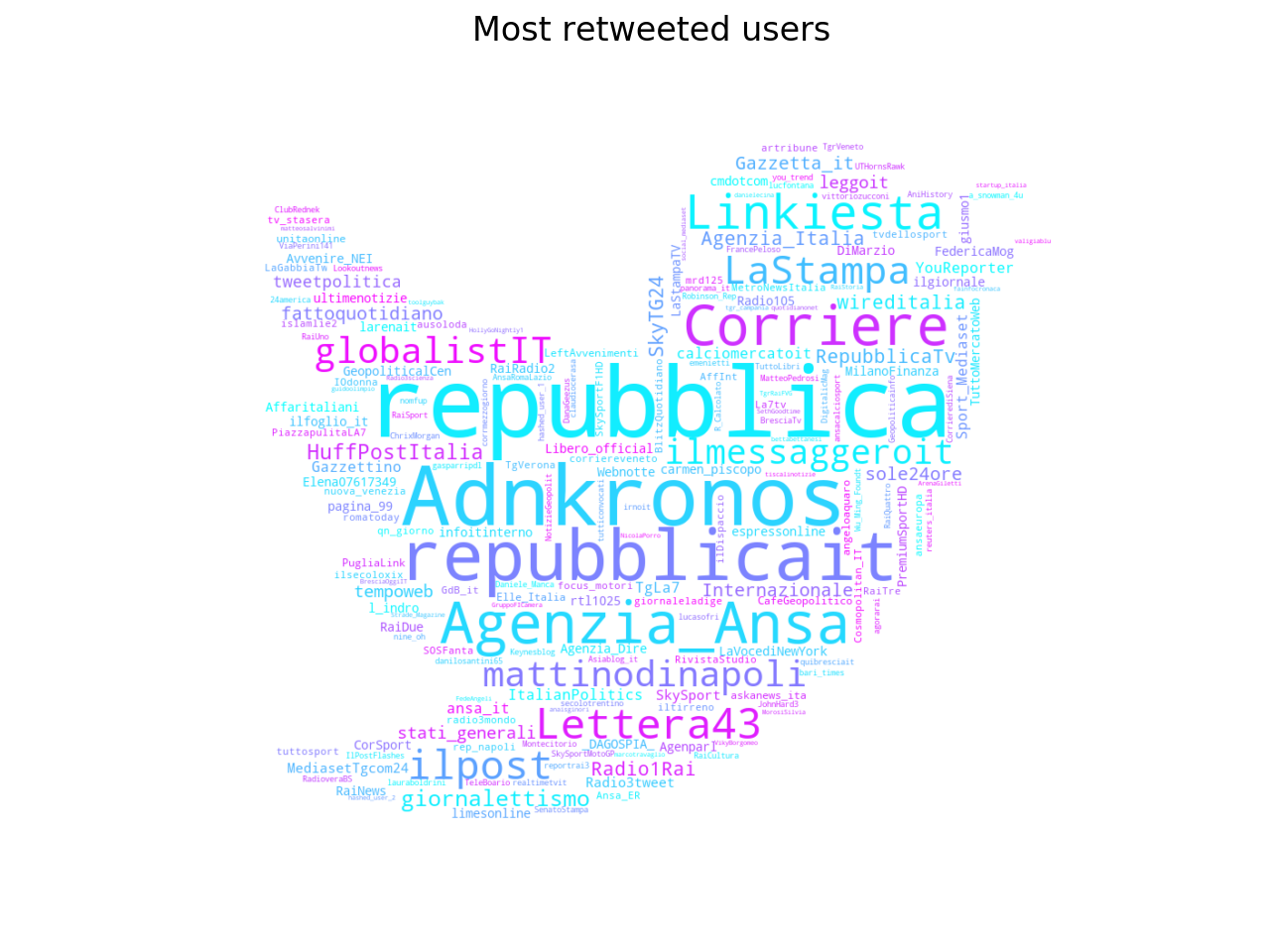
The most retweeted users are mainly mainstream media (e.g. Repubblica (@repubblica + @repubblicait) has been retweeted 2.640 times, 14,8% of all retweets). Half of the retweeted tweets were written by only twenty-six (26) users (1,2% of all retweeted users), and they are all Italian mainstream media accounts. There are only three propaganda accounts retweeted at least 10 times: @DanaGeezus (13 times), @ChrixMorgan (12) and an hashed user (10). The descriptions of these accounts are in English and very short, and they geolocalize themselves in the United States, so in my opinion they don’t seem influential. Among the top 100 most retweeted users, only three aren’t accounts of media or journalists. They are @carmen_piscopo, retweeted 44 times, @Elena07617349, retweeted 43 times, and @ausoloda, retweeted 24 times. The first and the third still exist, the second has been suspended by Twitter, but no one is an IRA account (according to Twitter). The users @carmen_piscopo and @ausoloda are similar [on 24 February 2019]: both have a high volume of tweets (253.000 and 227.000, they write 141 and 109 tweets per day circa), both retweet a lot, both have many favorites (184.000 and 83.200), both reply to other users. They seem semi-automatic or automatic accounts (in particular @carmen_piscopo is very peculiar in my opinion) and their behaviour isn’t so different from that of some Russian propaganda accounts. The user @Elena07617349 has been suspended by Twitter, so I can’t have precise information about it, by searching on Google I have found this username in some Italian sites ([1]21 - [2]22), and in a paper about the “networks of anti-Muslim hate on Twitter” ([3]23, pg. 78). This account has become viral on the Italian mainstream media sites (with no reason in my opinion), after its suspension, because of the hashtag #MattarellaDimettiti ([4] - [5] - [6]25). The wordcloud of the hashtags is useful to know the main news tweeted by the accounts of the IRA.

In the set of Italian tweets there are 5.580 different hashtags, used 15.071 times (obviously the numbers are lower than those of the tweets in German). The most used hashtag is the generic #news (used in 198 tweets), among the twenty most frequent hashtags there are many hashtags related to football (#SerieA, used 73 times, #Sports, 70 times, #Inter, 69 times, #Milan, 67 times), many about United States, the hashtag #Trump occurs 150 times and it is the third most frequent hashtag, #MAGA 92 times and #USA 86 times. The most used hashtags about internal politics are: #M5S (88 times), #PD (78) and #Renzi (77). The hashtags #Roma (163 times) and #Napoli (77) can refer to both internal politics and football. Some hashtags related to foreign policy are the same as the German ones, e.g. #Siria (78), #UE (72), #Londra (65), #Brexit (62) and #Migranti (61). In general there are many hashtags about sports, many concerning current events, but there doesn’t seem to be a scheme to “inflate” a particular topic. The strange hashtags as #AlternativeAcronymInterpretations and #ThingsMoreTrustedThanHillary are an error, some tweets with these hashtags are classified like Italian but they aren’t.
In the Italian tweets (tweets + retweets) I have found only 60 different emoji, the five most used emoji are 🇺🇸 (in 59 tweets), 🌴 (in 51 tweets), ✨ (in 19 twees), ™ (in 10 tweets) and ❤ (in 10 tweets). These emoji are also common in other languages (Spanish, French and Dutch), especially 🇺🇸 and 🌴, but (like for the strange hashtags) this depends on an error of Twitter in the classification of tweets’ languages.
Spanish
The tweets in Spanish have surprised me, because they are not as many as I thought. Spanish is the second language of the United States, spoken by 37 million people (circa 10-11%, source: WorldAtlas), and is the fourth language in the world (source: Wikipedia according to Ethnologue). I expected to find a large volume of Spanish tweets to polarize the Hispanic minority in the United States, since the propaganda campaign was mainly against the US. However, the data tell another story. Unlike the tweets in Italian and German, I didn’t expect to find tweets or retweets related to Spain (in Europe), but rather to the countries of Latin America and the United States.

There are 8.402 tweets and 4.400 retweets in Spanish (es) and they have generated 13.472 interactions: 6.991 hearts, 5.928 retweets and 553 replies. If I exclude ‘nan’ and ‘und’, Spanish is the seventh most frequent language in the set of tweets and the eighth most frequent in the set of retweets, but the number of tweets is small (there is a tweet [only tweets] in Spanish every 10 tweets in German and every 338 tweets in English). Even the interactions generated are not many, e.g. the interactions generated by French tweets are slightly greater. Unlike retweets in Italian, the “presence” of IRA users in the set of Spanish retweets is “large”: a retweeted account every twenty is a fake account and a retweet every ten is a tweet written by an IRA account.
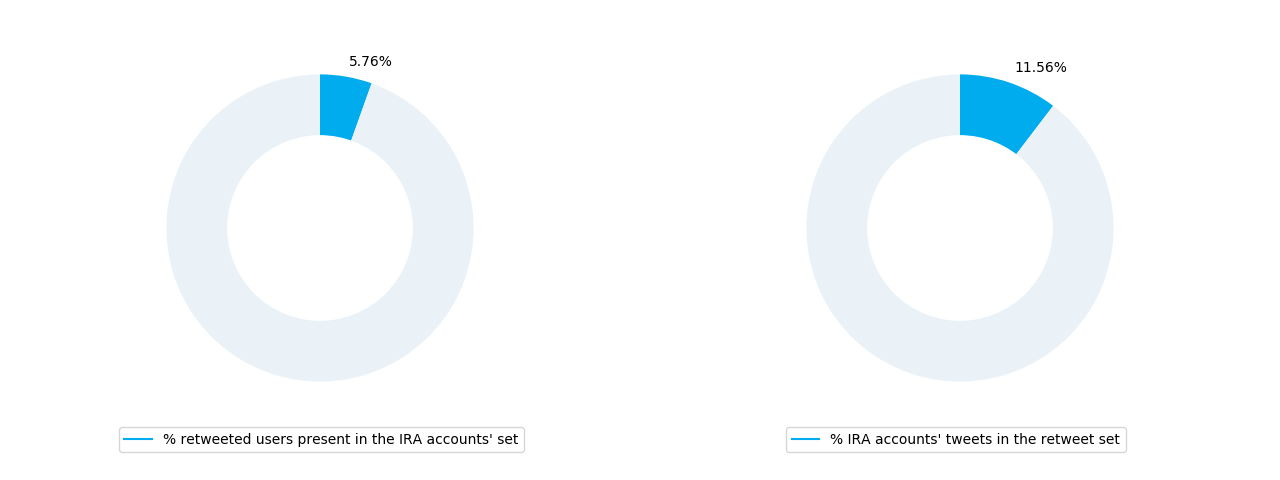
There are 1.872 users who have been retweeted, 108 of which are Russian users. The retweets are only 4.400, corresponding to 24,7% of retweets in Italian and 33,8% of retweets in German. The retweets written by IRA users are 509 (11,6%), to make a comparison: in the set of Italian retweets there are only 156 written by the IRA users.

The forty-eight (48) most retweeted accounts are the authors of 25% of the retweeted tweets, and they are 2,5% of all retweeted users. This data is interesting: in previous cases (German and Italian) very few accounts are the authors of many retweeted tweets, the situation for retweets written in Spanish is different, the retweets are more “distributed” among the various accounts. Another interesting data is the number of IRA users present among these forty-eight users: there are eight IRA accounts (16,6%) and this percentage is three times the one calculated on all the retweeted accounts. So it seems that the IRA accounts wanted to give greater prominence to their network and their contents, perhaps in an attempt to gain influence (this is an unconfirmed hypothesis). By manually checking the most retweeted accounts I have found that the Russian users are actually more than eight, because some users changed their username. The user @ElPaso_Post, the most retweeted one, changed the username to @ElPasoTopNews, which made it look like a local news site (it wasn’t the only one, according to this NPR article). Also the user @MariaMozhaiskay is an IRA user, but she changed her username to @MaryMozhaiskaya. In the fifteen (15) most retweeted users there are six (6) IRA users, two (2) users related to Russia (@ActualidadRT and @bookLoverRus), a spam bot (@AffiliateBuildr), a pro-Trump account (@UTHornsRawk, probably a bot), three (3) suspended accounts (@WorldLatinStar, @oldpicsarchive and @HipHopSpace), so remain only two (2) “clean” users. I have to make a special mention for @WorldLatinStar, because it is mentioned in several Italian news sites (e.g. TgCom24), it has been suspended by Twitter, but there is still its private Instagram account with a million followers. In the list of retweeted accounts there is also the account @Lettera43, an Italian news site, retweeted nine (9) times; this fact confirms the difficulty of Twitter to classify the language of the tweets.
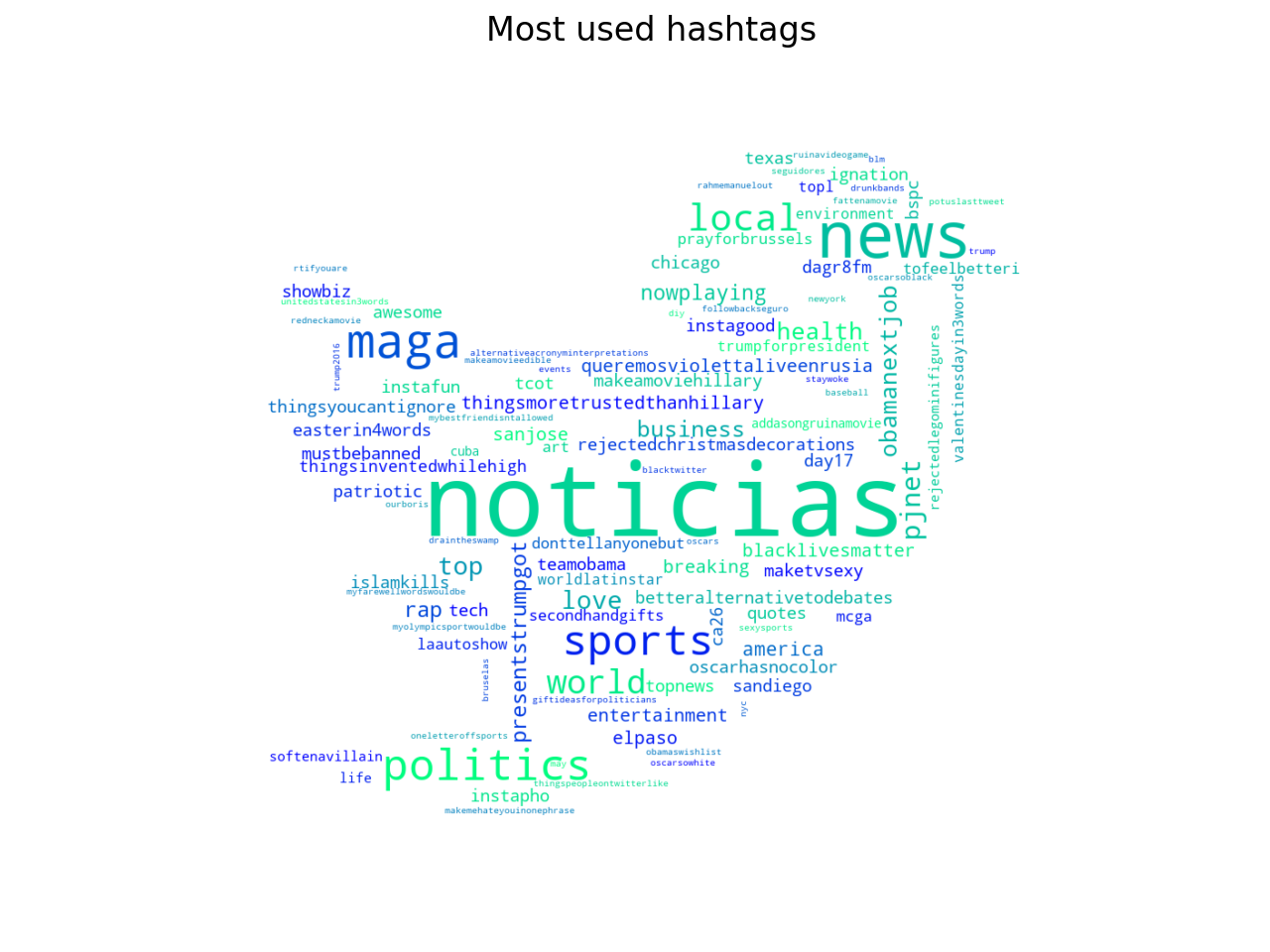
I have counted 1.918 different hashtags in the Spanish tweets, used 8.772 times. There are many generic hashtags, like #Noticias (the most frequent hashtag, used 1.969 times, in English it means “news”), #News (539 times), #Politics (217), #Sports (206), #Local (154), #World (121), #Rap (46) or #NowPlaying (44). The hashtags about the American elections are interesting, they seem to be directed to a specific target “close to” these elections (in my own opinion). There are hashtags about Obama (#ObamaNextJob, used 58 times, #TeamObama, used 22 times, #ObamasWishlist, used 10 times), Hillary Clinton (#ThingsMoreTrustedThanHillary, used 32 times, and #MakeAMovieHillary, used 22 times) and, obviously, Trump (#MAGA, used 268 times, #PresentsTrumpGot, used 47 times, #TCOT, used 30 times, #TrumpForPresident, used 15 times, and #Trump2016, used 10 times). There are at least seven hashtags about the black people and the problem of racism (e.g. #BlackLivesMatter is repeated 33 times), I suppose these trends were useful to polarise people (especially conservatives against a minority).
There are 121 different emojis, the most frequent one, used in 40 different tweets, is 🇺🇸, following by 🌴 (used in 21 tweets), ❤ (16), 😂 (11) and ✌ (10). Three of the five most used emojis are in common with those found in tweets in Italian, probably due to some mistakes of Twitter in recognizing the Italian and Spanish language.
French
The volume of tweets written in French, the volume of interactions, and the ratio between tweets and retweets are similar to those of tweets written in Spanish, but the two sets of tweets are very different in terms of quality. Like Spanish, French is also widespread in the world, it is spoken in France, in many African countries and in some regions of Canada. However, it is less widespread than Spanish, especially in the United States.
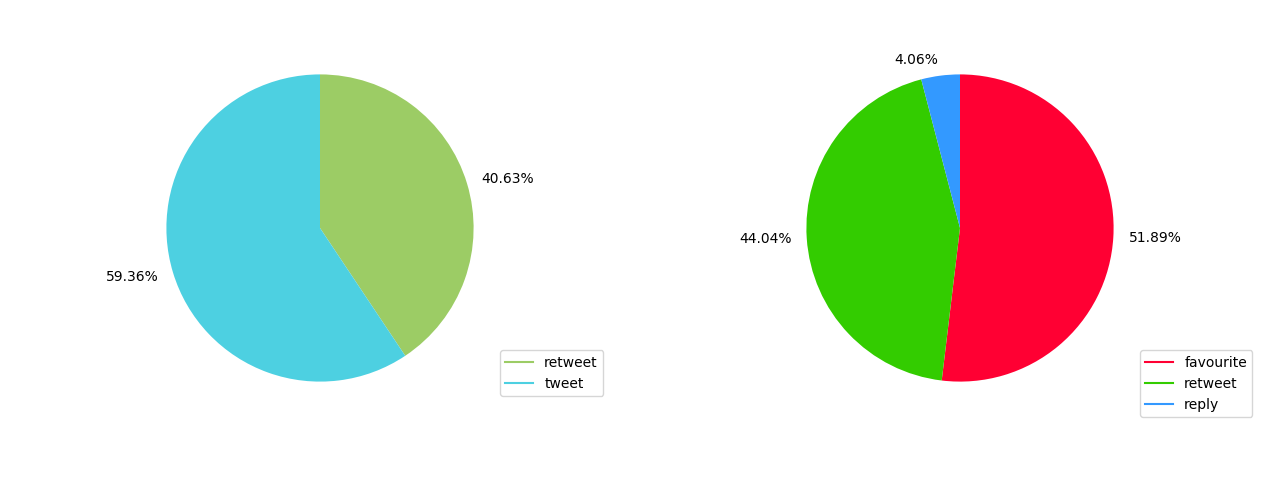
There are 7.501 tweets and 5.135 retweets in French, and they have generated 16.351 interactions (8.486 hearts, 7.201 retweets and 664 replies), little more than the Spanish ones. By excluding the labels ‘nan’ and ‘und’, French is the seventh most used language in the retweets, behind Italian and German. In this analysis I have not dealt with the temporal evolution of the various tweets, I hope to have time in the future to deepen it, in order to understand if the Russian propaganda increased during the French elections.
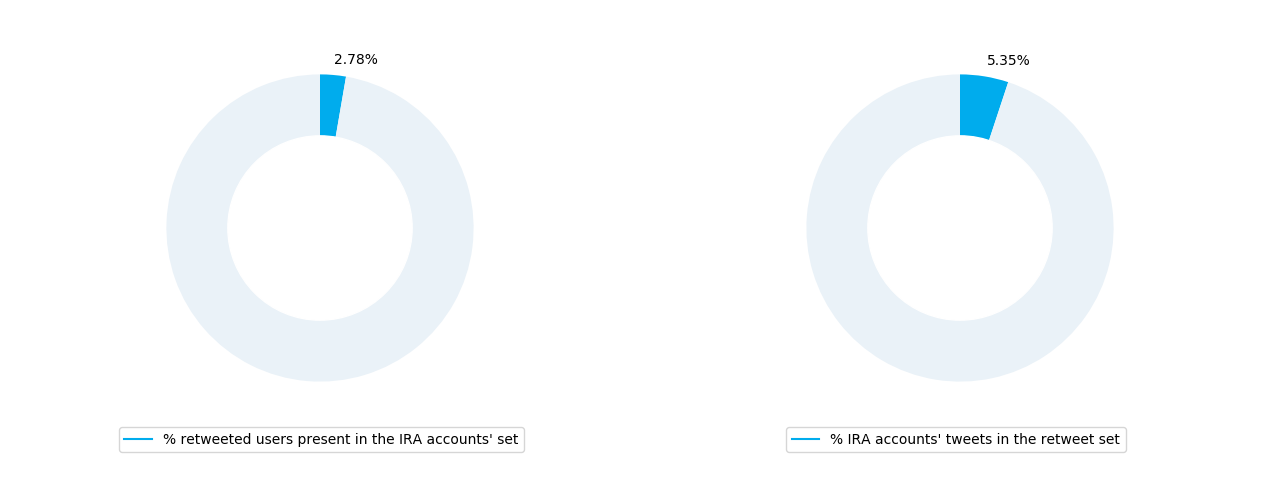
The retweeted users are 2.189, 61 (2,8%) of which are accounts of IRA, and there are 275 (5,4%) retweeted tweets created by Russian propaganda accounts. Unlike previous cases, there are two important French politicians that are very retweeted (the two candidates in the last election). In my opinion this is the most important fact about the retweets written in French and I have several hypotheses about this:
- Russian propaganda accounts have tried to strongly influence the French elections, by retweeting politicians as well
- Russian propaganda accounts have used different propaganda techniques for each target
- France has a two-round electoral system, with only two candidates. This can create a polarization and therefore the propaganda accounts have only retweeted the two leaders in the run-off
- Twitter was wrong to classify some accounts ⁴, and there is another network
- Other possibilities I have not thought about yet

The situation regarding the propaganda in French is chaotic: there are tweets and users that mainly address France and the French elections and other users and trends that affect the American elections, probably because of Canada, where people speak also French. 25% of the retweeted tweets were written by forty-seven (47) users, and four of them (8,5%) are in the IRA accounts list. By observing these users in detail, there are only four IRA accounts, but there are twelve (12) suspended accounts: @Voltuan, @ZombiaxX, @AllenWestRepub (become @GreatAmRepublic), @WashDCOnline (become @WashingtOnline), @C2017DebouCracy, @oldpicsarchive, @NOrleansDaily (become @NewOrleansON), @CarlosVFrVN, @DetroitPost (become @DetroidDailyNews), @amrightnow, @HaussmannParis and @AntiLeftistsFas. In my opinion, either did the Russian trolls retweet many accounts that didn’t respect the terms and conditions of Twitter (trolls retweet trolls), or Twitter has suspended (is still suspending) some popular accounts among IRA accounts. There is another interesting fact about these forty-seven accounts, some retweeted users seem to be related to France, others to the United States, as if French was used to make two different types of propaganda on France and the USA. In my opinion the users retweeted to spread propaganda in France are: @Voltuan (the most retweeted user, 162 times), @MLP_officiel (retweeted 58 times), @ZombiaxX (38), @Le_Figaro (29), @afpfr (25), @paoegilles (24), @gabriellecluzel (24), @EmmanuelMacron (24), @Elysee (22), @CarlosVFrVN (21), @AllAfricafrench (20), @HaussmannParis (16), @Marion_M_Le_Pen (14), @lemondefr (13), @franceinfo (13) and @ThomasWieder (13). The accounts that I think were used to spread propaganda during the American elections are: @AllenWestRepub (99), @UTHornsRawk (27), @WashDCOnline (26), @NOrleansDaily (24), @ESPEZY (22), @AnnoGalactic (21), @DetroitPost (17), @amrightnow (17), @CBCNews (16) and @darren_huxter (15). There seems to be a difference between propaganda in Europe and propaganda in the United States: in France the retweeted media are trusted and known, in the USA the retweeted accounts are local media, often false, and then suspended.
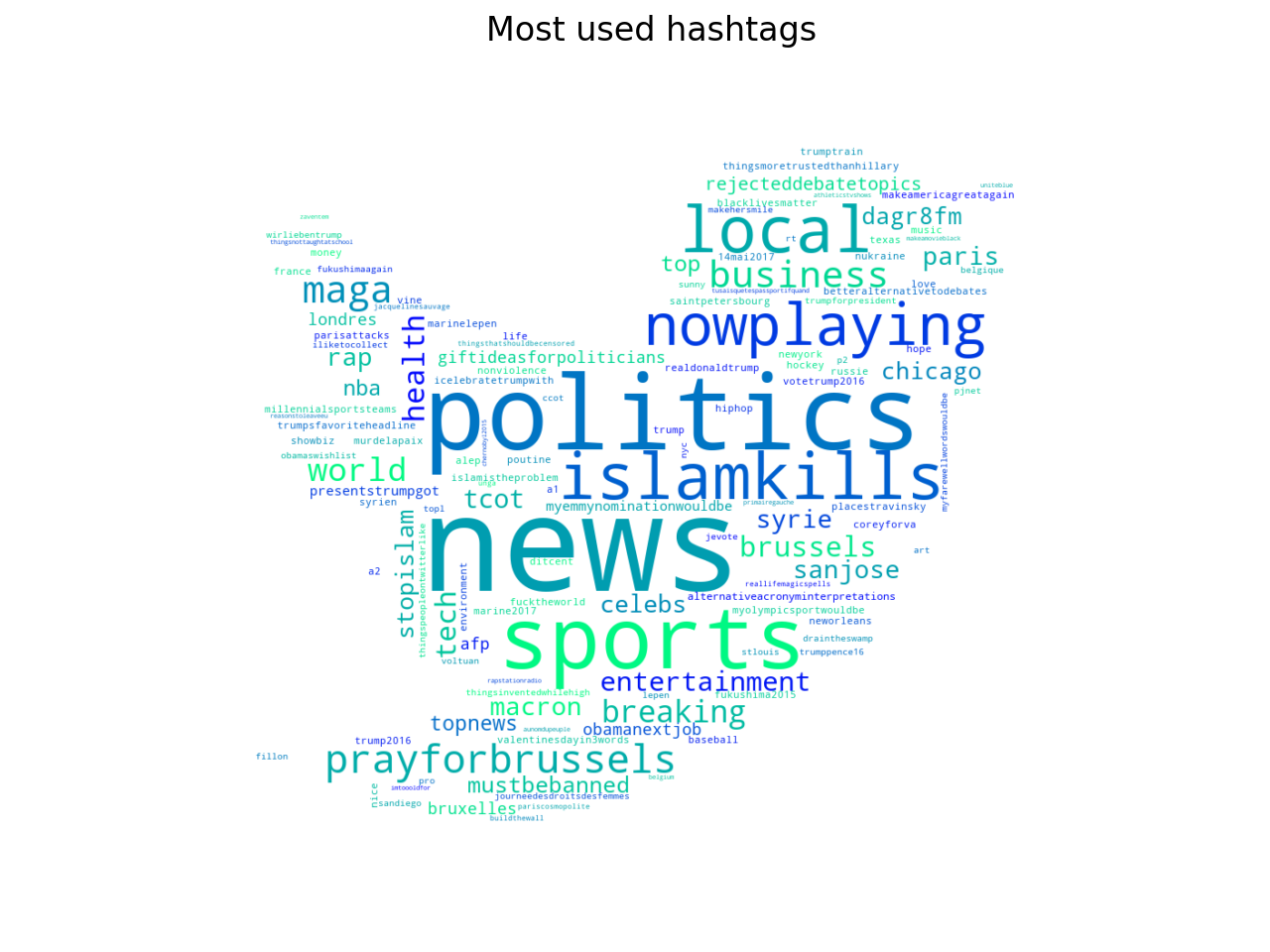
The wordcloud of all (2.287) hashtags confirms the point of view written above. Many hashtags (e.g. #News, #Politics, #Sports, #Local, #NowPlaying, #MAGA, etc) are the same as those present in many tweets written in Spanish, this fact could be an acknowledgement that some tweets in French were intended to influence the American elections. There are also some hashtags concerning France and French politics: #PrayForBrussels (used 115 times), #Brussels (58), #Paris (51), #Macron (50), #Londres (32), #ParisAttacks (24), #Marine2017 (19), #14mai2017 (18), #MurdeLaPaix (18), #MarineLePen (17), #Fillon (14) and #JeVote (13).
In the tweets written in French I have found 102 different emoji, the five most frequent are: ❤, used in 34 tweets, 😈, used in 22 tweets, 🇺🇸, used in 21 tweets, ™, used in 13 tweets, and ✨, used in 12 tweets. Also in the French tweets ❤ and 🇺🇸 are among the most used emoji.
Holland and Denmark
The data concerning the tweets written in Dutch and Danish isn’t reliable to make an analysis. Initially I decided to read it because I thought Twitter had correctly classified the language of the tweets, but there are many errors. The errors are compensated on large numbers, but not on small numbers. However the numbers of tweets written in Dutch and Danish are small: there are 2.292 tweets and 1.249 retweets classified as ‘nl’ (Dutch) and they have generated 2.009 interactions (1.029 hearts, 890 retweets and only 90 replies) and there are 2.700 tweets and 873 retweets classified as ‘da’ (Danish) and they have generated 3.173 interactions (1.500 hears, 1.543 retweets and 130 replies). The hashtags are mainly in English, confirming the fact that Twitter has difficulty classifying the language of the tweets.
My Two Cents
In this post I have worked on some data extracted from the dataset published by Twitter, I have focused on tweets and retweets written in some languages present in Europe (German, Italian, Spanish and French), on the retweeted accounts and on the hashtags used by the IRA users to try to understand if there was propaganda in Germany, Italy, Spain and France. I have started this post with a question: has there been Russian propaganda in Europe? And in Italy? I’ll try to draw my own conclusions:
- Twitter has not correctly classified the languages of some tweets (usually short tweets), this hasn’t helped me to analyze the data because I can’t completely trust the dataset. A good example are the tweets with the emoji 🌴, classified as Spanish or Italian. The tweets with the palm emoji are mainly quotes, with the addition of silly hashtags (e.g. #Top), of tweets very similar to this tweet by @TerreBehlog (now @Nov2020election). The tweets are mainly in English, but are mistakenly classified as Italian and Spanish.
- Twitter was wrong to classify some accounts⁴. In January 2019 Twitter has removed 228 users from its dataset of IRA accounts, shared in October 2018, because these accounts seem to belong to a different network, coming from Venezuela. Twitter has never said how it classifies propaganda accounts, but it is clear that it is an uncertain procedure even for Twitter. Unfortunately I analyzed the dataset before January 2019, so these statistics are based on the incorrect dataset. I hope the final results aren’t so different.
- In Germany it seems that the Russian trolls have tried to alter and polarize the topics on Twitter, I don’t know if the Russian propaganda has worked and I can’t quantify its effects. Germany is one of the countries where the trolls have been most active (together with Russia, Ukraine and the United States). In my opinion the best analysis about Russian propaganda in Germany was written by Luca Hammer, you can read it on Twitter or on Threadapp.
- In Italy the IRA accounts weren’t very active (they wrote a few tweets), but they shared a lot of information in Italian via retweets. Shared retweets come from mainstream media, concerning various topics, the political hashtags mainly concern the PD (Democratic Party) and the M5S (Five Star Movement). I can’t conclude that there has been Russian propaganda in Italy, but the large number of retweets is suspicious. In Italy, in August 2018, many newspapers discussed Russian propaganda in Italy and the FiveThirtyEight’s dataset, the best analysis (in my opinion) was written by Marianna Bruschi [link to Twitter].
- The tweets written in Spanish don’t have hashtags or retweeted accounts that can be connected to Spain. The propaganda target is the Latin minority in the United States and this propaganda is very different from that seen in Germany: many retweeted accounts have been suspended, many of them were trolls, many hashtags refer to the American elections, and retweeted news is written from local news sites (fake) and not from trusted accounts.
- The tweets classified as French are very important: they are the example of different propaganda for different targets. In the French tweets there two main sets: one similar to the tweets written in Spanish and one similar to the tweets written in German. In the first one there are propaganda tweets about American elections, so there are many fake accounts of local news, in the second one there are mainly retweets from trusted accounts (e.g. @Le_Figaro, @MLP_officiel, @EmmanuelMacron and @Elysee).
I hope to conclude these statistics by analyzing the retweets and tweets in Italian.